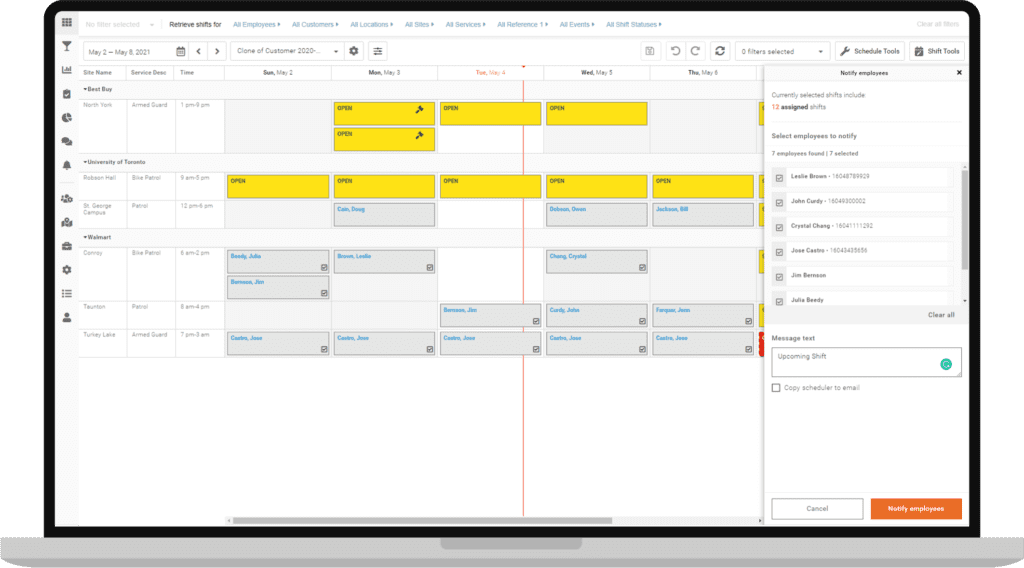Every business has an idea of the best shift patterns they can use. Whether you operate 9-5, or work around the clock – there’s an ideal for everyone. But like few other sectors, the healthcare sector comes with additional pressure that makes the process extremely important. The shift patterns a healthcare business chooses may need to support those whose livelihoods rely on it.

It’s true. The healthcare sector really is unlike any other. Unpredictable demand. Rotating shift patterns. Growing skill gaps. New and complex compliances with COVID-19. The list goes on. Can you even imagine running an operation that needs to consider these factors?
We’re not saying that a range of shift patterns will solve all the healthcare sector’s problems. But they can certainly help.
Let’s look at what a shift pattern actually is.
What are shift patterns and why are they used?
The term shift pattern refers to a schedule of working where employees work shifts in rotation. Shift work is typically used by businesses that require operation outside of traditional hours. The purpose of this is to ensure that they have a sufficient number of employees to meet demand.
A Statcan article states as many as 30% of the Canadian population work shifts that are non-standard hours. But just how beneficial are these differing shift patterns to the healthcare sector?
Let’s dive into some of the more obvious benefits and drawbacks.
A big benefit
One of the biggest benefits to healthcare businesses is giving employees autonomy over the shifts they work. Flexibility over when and where they work can help to improve an employee’s work-life balance. A better work-life balance keeps them more motivated and makes them feel more engaged in their job. Having happy employees makes it far easier for businesses to retain employees and reduce absenteeism because they’re living a healthier, more convenient lifestyle. This helps in creating a more productive workforce.
Having healthy shift workers at their disposal means healthcare businesses can provide high-level service whenever and wherever it’s demanded. If they do struggle to fill shifts, they can use compensation, recognition or reward incentives as additional motivation.
The benefit of more employee power has long been common in the healthcare sector. But post-pandemic, shift work has not always provided a platform of convenience.
A distressing drawback
The healthcare sector is notorious for irregular shift patterns due to fluctuating demand. But recent times have been unprecedented. The COVID-19 pandemic has had an even greater impact on this sector than anyone could have foreseen. And this has sometimes been to the detriment of employees and their inconvenient shift patterns.
Many employees operating in the healthcare industry have suffered from being overworked during this period of excessive demand. The U.S. Bureau of Labor Statistics stated that 4.5 million have quit or changed job since 2021. And because of this, healthcare lies within the top 3 of the worst effected sectors in the world.
This period has been dubbed as the “Great Resignation”. And to this day, healthcare businesses face an uphill struggle. This uphill struggle is to convince employees who are undertaking irregular shift patterns that they’ll receive the flexibility they’re promised.
Now we’re going to explore some shift patterns that may suit your healthcare business.
Fixed shift patterns
Fixed shift patterns relate to a set of regular shifts that do not change. Typically, employees work around 40 hours a week and their schedules are unmoved unless to cater for impromptu circumstances.
Let’s look at some examples:
9-5, 8-4, 10-6 shifts – Away from the world of shift work, this shift pattern gives you less flexibility, but more balance. And it ensures that healthcare businesses will always be operable at the busiest working hours.
Maintaining sustainable care
When it comes to healthcare businesses, these shift patterns can be pivotal in providing sustainable care through the busier periods of the day. Not only does this impact help to steady demand, but improves employee performance too. A Research Gate report stated that nurses working fixed shifts experienced fewer physical and psychological problems than those on rotating shifts.

A fixed shift pattern allows employees to forecast non-work and other social activities more easily. The complete control over their shift pattern gives their business the performance to sustain an essential service. But despite the given certainty of when and where these employees will work, the recent pandemic has seen the traditional 8-hour shifts become a thing of the past.
Rotating shift patterns
Rotating shift patterns are essential in many healthcare businesses. Without them, essential services simply couldn’t operate at all times.
All day, everyday
These shift patterns are based on the need and demand of healthcare services. The healthcare sector’s primary services don’t work on a periodic schedule. They’re 24/7. 365 days a year.
As long as federal labor standards are met, employees may find themselves working morning, afternoons, evenings, or nights. All in one week.
Let’s look at some common examples:
- 2 shift – The two shift is a shift pattern that breaks two shifts to cover the period of time required by a business. For example one shift could be 12am-12pm, and the second 12pm-12am.
- 4 on 4 off / 7 on 7 off – A continuous shift pattern that gives 24/7 coverage throughout the entire year. An example would be having different teams of employees working 4 or 7 days of 12 hours a day, then resting 4 or 7 days. This can be rotated to ensure coverage for all 24 hours of each day.
Some healthcare business may choose less traditional shift patterns that best suits them.
Find the best ways to schedule
We know all too well how tricky the management of a rotating schedule can be. So, make sure you find the most cost-effective and optimize approach possible.

In many cases, the larger healthcare businesses will create a schedule based on employee availability which can be created within a best-of-breed employee scheduling software. Employee scheduling software allows larger businesses like hospitals to determine shift cover more easily. Modifications can be made to show a scheduler who’s best to cover a particular shift based on the role requirements and the employee skillsets on offer. Also, they can assist you in avoiding any workplace conflict.
Before choosing their shift patterns, healthcare businesses must integrate competent employee scheduling software. They’ll thank us later.
Rotating shift patterns and what they mean for the healthcare sector
The indispensability of the healthcare sector and its businesses mean that rotating shift patterns are required. And you’ll be glad to hear that they have many benefits.
Keeping your workforce happy
Where some employees enjoy a steadier schedule, others prefer working the quieter times of the day. Having a rotating schedule gives you and your employees room for flexibility. It can ensure they’re working at different times in different environments, which allows them to meet some new faces. Rotation can also help teams to create cohesiveness and build teamwork for optimizing their productivity levels.
Not only will your workforce be happy, but you can spread the talent all around.
Spread the talent
Spreading your employees’ talent is all about creating the perfect balance. It’s probably not healthy to have all your highest-level skilled employees working the same shift pattern. Unless your demand tells you so.
By having a mixture of expertise throughout the shift patterns you create, you’ll benefit from growing your workforce. It’s natural that those with a lower skill set will learn more from being around more experienced employees. Rotating shifts to allow for training opportunities is an excellent way to bolster the skillsets in your workforce.
Some healthcare businesses are blessed with the most skilled workforces. But what good is that if your employees fit and ready to tackle their tasks?
Health Issues
The health issues associated with rotating shift patterns are a cause for concern. Not only are many healthcare businesses’ employees dealing with the pandemic face-to-face. But they’re also being overworked because of workforce shortages. This is having a huge impact on other aspects of their own personal health.
The short-term effects are the usual suspects. Fatigue. Increased risk of injury. Decreased quality of life. But the long-term effects have more dire consequences. Especially for those working night shifts. Depression through social isolation. Obesity through lack of personal time for exercise. Cardiovascular diseases result in heart attacks.
These overwhelming issues have caused the “great resignation”. This has largely been fuelled by low-wage jobs and grueling conditions. Even the increase in night shift pay isn’t enough to stop employees from turning their backs.
As well as the associated health issues, the lack of progression in the workplace has been a concern of many employees. There’s long been a “knowledge gap” in the healthcare sector and it seems some are becoming well aware of this.
Closing the knowledge gap
Despite the lack of time to close this knowledge gap, rotating shift patterns have made it even harder. In the past, varying shift patterns have often allowed nurses to practice overnight. With less disruptive processes and in a pre-pandemic world, it was once possible. But now, attention has turned to learning new practices to heal new wounds in the sector. Wounds that are putting our healthcare sector employees at a greater risk than ever before.
To cope with the excessive demand, employees have been working non-stop. And the additional 9.7% healthcare expenditure per year has meant that the government is struggling to fund other practices. Poor health literacy and a lack of new health systems may have come at a big cost.
So, which shift pattern should your healthcare business use?
The answer to this question lies in the type of healthcare business you work for.
When we think of healthcare, our minds are naturally drawn to primary care. Environments like hospitals that provide 24/7 emergency. Doctors, physicians, nurses. These ‘businesses’ know no timeline to the care that they provide. However, secondary care are specialists who are referred to help with specific issues. Typically, they work on a timeline that spans morning through to evening.
Primary care
Primary healthcare businesses require both fixed and rotating shift patterns to operate at full capacity. The busier periods in the daytime are likely to require fixed patterns that cater for general needs. Whereas the evening through to the night is generally more sporadic and requires an element of flexibility. The type of rotating shift pattern will often come down to the number of employees at their disposal. The mix of shift patterns goes a long way in helping to curb the ever-growing and inconsistent demand.

Secondary care and beyond
Secondary and other types of care are often performed once an appointment is made. These are scheduled through daytime hours unless in the rare case of emergency. Most specialists working in these fields will work the more traditional, fixed shift patterns.
To those in the healthcare sector…
Despite the continuous struggle of unprecedented demand, the healthcare sector continues to push through an incredibly strenuous period. Shift patterns are now unorthodox. Finding enough people to fill a schedule has become trouble of its own.
We know how complicated yet crucial a best-fit schedule can be. But one day soon, we hope that the healthcare sector and its employees can reach a stage of normality.





